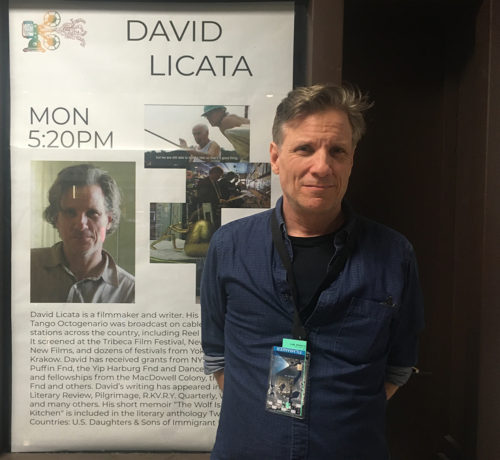Here’s a recap of A Life’s Work’s premiere at the 19th Kansas International Film Festival. Yes, it was more than two months ago.

I attended the festival, but did not sit in on the screening, and thank god for that! The sound dropped out several times, and for more than just a few seconds, and once at a crucial point. Had I been in the audience, I would have had a stroke.
The staff gallantly tried to fix the issue, but to no avail.

When I returned home I was afraid to look at the copy I sent them. So, after a week I saw the issue was the file I sent them. So ultimately this turned out to be my fault, since I should have watched the film in its entirety before sending it to the festival. But I was really late in getting it to them so I settled for watching the first 10 minutes and a spot check. Everything looked and sounded fine. Lesson learned.
Even though this technical blip has been resolved, I am still angry at myself.
Now the good news.
The room was small (cute!), about 70 seats, and there were 60, maybe more, people in them.

No one walked out, despite the tech issues. Not bad for a Monday early evening on a day when it snowed and the roads were slick. A few people left when the lights came up but the vast majority stayed for the Q&A. There were many good questions, most of which I addressed in the blog at one point or another (see below), no uncomfortable pauses when the audience was asked if they had questions and no pauses between questions. The moderator had to stop taking questions to get the audience in for the next film.

The highlight came when I was introduced for the Q&A and I passed a woman on the way out. “Okay. I need more faith,” she said to me, quoting a line from the film.
“That’s one of my favorite lines!” I said as she walked up the aisle to the exit. I didn’t mind at all that she didn’t stay for the Q&A.
Here then were the questions I was asked.
Do you think of the film as optimistic or pessimistic?
I think of the film as optimistic, and it was never my intention for the film to bum people out. Yes, the people in the film will not live long enough to see their project completed,* but they are all contributing knowledge to humanity’s enormous database so that the next generation can pick up where they left off without missing a beat. This is why you’ll see shots of Jill Tarter with students who were interning at the SETI Institute; Robert Darden with Tony Tadey, the young man doing the digitizing of the records; David and Jared Milarch talking about past generations of Milarchs as well as the next generation; and Paolo Soleri and Jeff Stein, the most salient example of someone standing on the shoulders of giants. (By the way, the story of that quote [by Isaac Newton] is a nifty science history sidebar.)
You took 15 years to make it. Tell us how you went about making it over that long period of time?
When I began budgeting and planning the film, I figured it wouldn’t cost a lot to make (relatively) and that if I managed to get the money, I could finish it in two or three years. If is the operative word there. It turned out grant givers were not lining up to support the film, and so I’d save up just enough money to do the next shoot, get it done, edit what I could, and try to get more money from various leads for the next shoot.
I paid for a lot of shoots with tax refunds. Everything related to the shoot was a business expense, so money I spent on a shoot we did in 2009 would be refunded in 2010, say. Then I’d spend that money in 2010, claim it as a business expense and get a refund in 2011. There is nothing shady about this. Everything was above board and all the expenses were legit.
That being said, it’s not the most efficient way to fund a film.
Do I know the location of the Methuselah tree?
No. Very few people know the location, and I’m not one of them. Jared Milarch knows it, because he was the one who took the clippings. The park service does will not disclose its location for fear that it will vandalized.
Are you still in touch with them?
Yes. Except for Soleri, of course. Some I am more in touch with than others, but all of them are dear to me.
Where did the idea come from?
See “Origins of the Film” for the answer.
How did I find these people?
Follow these links for the answer.
Paolo Soleri and Arcosanti
Robert Darden and the Black Gospel Music Restoration Project
David and Jared Milarch, Champion Tree Project/Archangel Ancient Tree Archive.
Jill Tarter, the SETI Institute.

